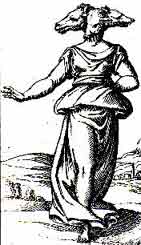Ci porta dapprima in zone cangianti e ricche di tensione, fino al primo picco espressivo del pezzo rappresentato dal prolungato grido dei due clarinetti proiettati agli estremi opposti del loro registro; arriviamo quindi alle calde atmosfere della parte centrale: una morbida linea disegnata dai due clarinetti e dalla marimba, quindi i canti dei fiati e del violoncello in un panorama sereno, pacificato.
L'irrompere della quarta sezione ci presenta gli atteggiamenti precedenti esasperati nei loro tratti caratteristici, fino al triste commiato finale, che vede un residuo frammento di canto spegnersi in un semitono sempre più esitante del clarinetto, su un ostinato meccanico e freddo della marimba, appena rassicurato da lontani echi degli altri strumenti.
Ecate, divinità notturna, ci abbandona.
 Goddess of the Night, companion of the spirits of the dead, protectress of the roads; Hecate, shady divinity, guides us with the unstable strenght of her myth through the pages of this work.
Goddess of the Night, companion of the spirits of the dead, protectress of the roads; Hecate, shady divinity, guides us with the unstable strenght of her myth through the pages of this work. At first she brings us into iridescent and rich zones of tension, where in a kind of introduction, bursts of energy and unsettled lulls alternate.
We then arrive in territoires dominated by strong-willed resorts; and yet, with sudden anxious stops, the work finds its expressive peak in the prolonged scream of the two clarinets projected to the opposite extremes of their registers. the sudden return to the hesitant initial situation leadsour path towards the warm and soft atmospheres of the central part of the piece; at first, a soft line outlined by the two clarinets and the marimba, then the singing of the winds and the cello depict a serene and peaceful panorama.
The interruption of the nervous and contradictory fourth section presents to us the preceding expressions, exasperated and rigid in their characteristic lines: extreme violence in the dramatically agitated pauses, while the soft melodic line transforms itself into almost still and static contemplation.
The sad final farewell sees a residual fragment of song progressively disappearing semitone by hesitant semitone on the clarinet over a cold mechanical marimba ostinato scarcely reassured by the distant echoes of the other instruments.
Hecate, nocturnal divinity, abandons us.

